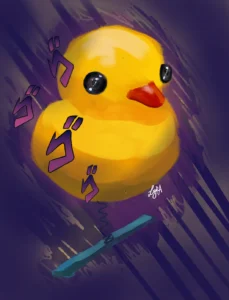FEATURE
DUCKS: A CROWN JOY AND UNITY
by Jaime Bernabe Alonzo II

ILLUSTRATED BY: LYRA EMILIANO
It was a cold late December. This was the first time in months for some to come back to the city of Baguio. It was the same as it always had been. The loud beeping of cars, the shouts and murmurs of passersby, and the overflowing numbers of people occupying the city walls and streets. But wait a minute! Something is wrong. As one may squint their eyes and look at the y e l l o w objects clipped at the heads of each person walking by – there was a duck.
A little ducky that can be placed on the top of the head as a hair clip and has different variations from a duck wearing sunglasses, roses, and traffic cones. One can easily join this fad with only 35 pesos in hand. This duck accessory plays a role in presenting the healthy social inclusivity and trends of the city.
Here’s a mind-boggling question, what if these little ducks originated as a symbol of unity of the masses and a sign of resistance towards media censorship?
Hong Kong Ducks
This is the story of how Hong Kong, an administrative region of China united its people and created a symbol that would be an act of defiance towards the media censorship of the People’s Republic of China (PRC).
Hong Kong in 2013 celebrated its inaugural “Art Basel Hong Kong” by inviting art collectors from all over the world to participate in its art-themed galas held by galleries and celebrities.
For the 7 million inhabitants of the city, attending V.I.P. and high-end art sales feels like a dream come true, most of them, however, are more concerned with the art installation called “Spreading Joy Around the World” also known as “Rubber Duck.” By a Dutch artist Florentijn Hofman. The six-story-high childhood bathtub favorite was set afloat in the Victoria Harbor of the city.
Thousands of Hong Kong residents gathered around the waterfront to witness the “Rubber Duck”. Since then, countless duck-themed products have shown up at shops and restaurants. From rubberduck-themed outfits to tourist kiosks selling rubber duck postcards and many other forms of rubber duck-inspired products. The “Rubber Duck” art installation months later to the horror of the crowds, fell on its beak and slowly capsized before deflating into a bright yellow puddle.
Ducks ducking in politics
The South China Morning Post, the main English-language broadsheet, has published no fewer than 19 articles, opinion pieces, and blog posts about the rubber duck frenzy. One editorial done by the paper “Giant Rubber Duck Has United City,” argued that it did more to inspire Hong Kongers than a recent government drive to raise morale.
The rubber duck craze did not stop there, it also made its way to Chinese social media platforms creating memes and even a parody of the iconic 1989 Tianmen Square photo wherein the Chinese military in 1989 violently broke up a 6-week student pro-democracy rally. Ordered by the nation’s hardline leaders to suppress the demonstration, troops entered the square with tanks and assault rifles, killing hordes of students who refused to move. Anywhere from 400 to over 1,000 unarmed protesters died (actual numbers not yet released).
Although China has undergone dramatic changes in its economy in the years since its government remains authoritarian in practice, officials are quick to censor and limit freedom of speech which includes the censorship of t h e country’s war crimes and injustices. Therefore, banning the rubber duck parodies of the 1989 Tianmen Square massacre.
Matthew Green, author of “How A Rubber Duck Meme Sidestepped Censorship on Tiananmen Square Anniversary” noted that “The rubber duck meme was temporarily removed by Chinese censors after it first appeared online in 2013, but reappeared the following year. Even the most subversive memes, it turns out, have limited shelf life.”
Good things come in pair
Two of the Beloved “Rubber Duck” of Dutch artist Florentijn Hofman ten years later would be seen once again floating on the shores of Koahsiung City in Taiwan. Come once again the boom of wearing the duckling clips to commemorate the special occasion, spreading to its neighboring country the Philippines which also jumped into the ruby duck fad with haste.
“To be honest, I hesitated a bit if it could match up with the 2013 experience. So, I had to think it over twice and there you have it, not one but we have to bring two ducks, Double duck – Double luck,” explained Hofman.
The ducks given
One may walk through the city park and see groups of people with yellow duck clips standing above their heads, laughing and talking, taking selfies and videos with their cute clips.
Ducks are seen as a symbol of happiness, conjuring childhood memories and nostalgic narratives, irrespective of age and race. Whether it’s a symbolic act or a cute trend, there is no denying that the duck clips are taking over and making an impact across the countries of Asia.
The City of Baguio and its duckling clip mania only prove that we can find joy and similar interests in things as small as a duckling clip. It shows that we as a community can be unified with even the simplest of things.

One Response